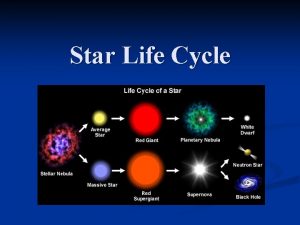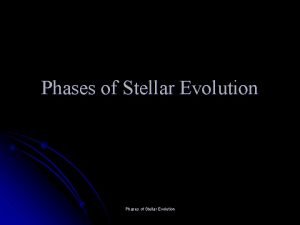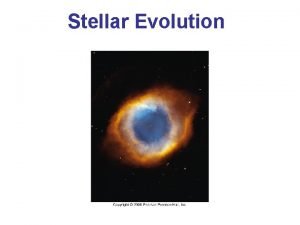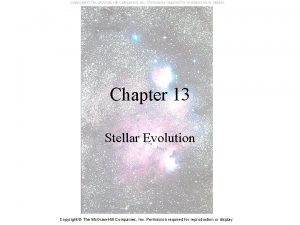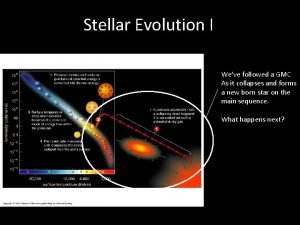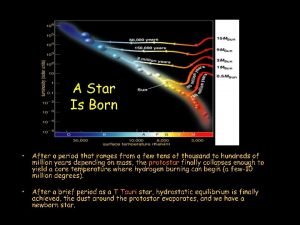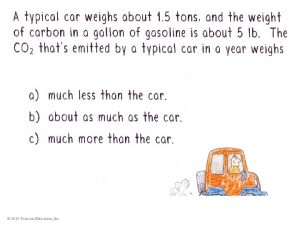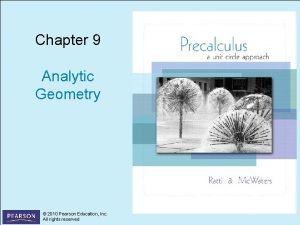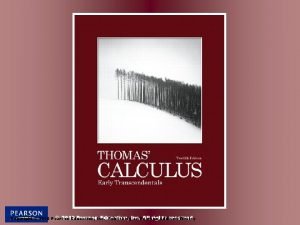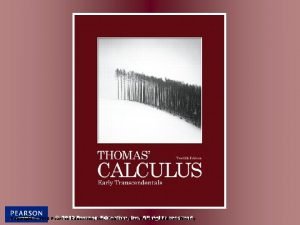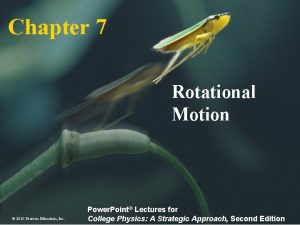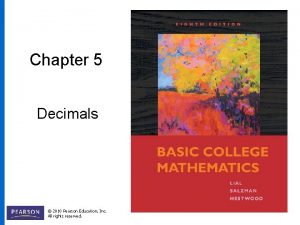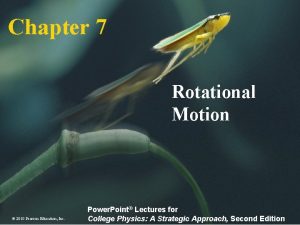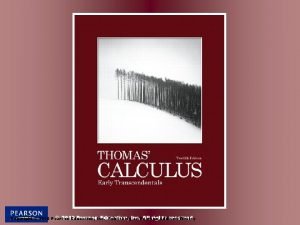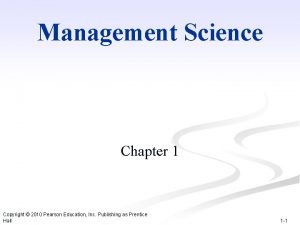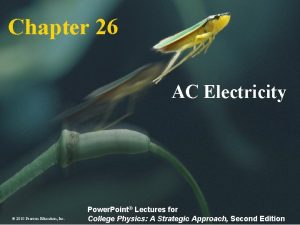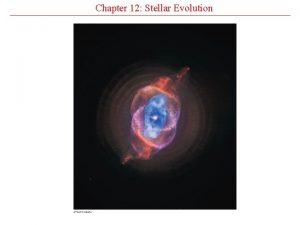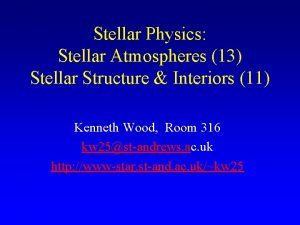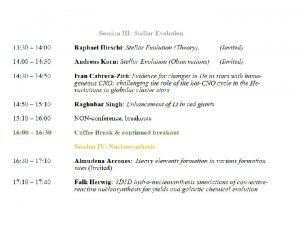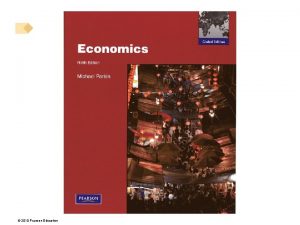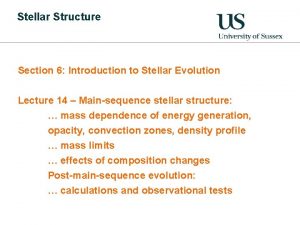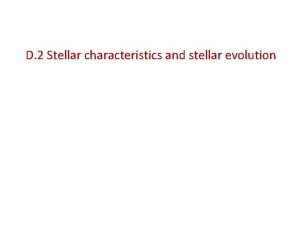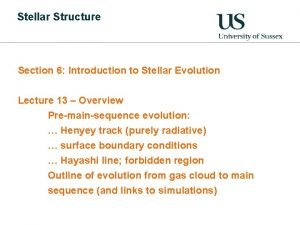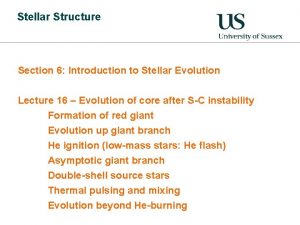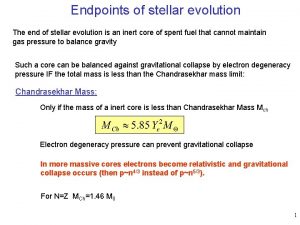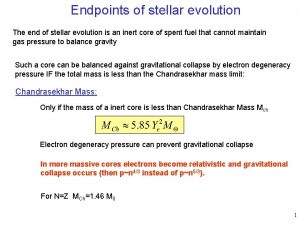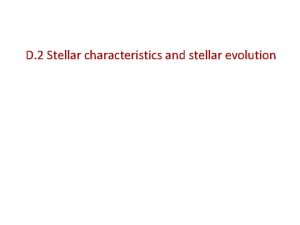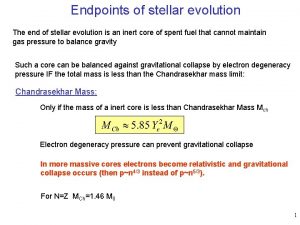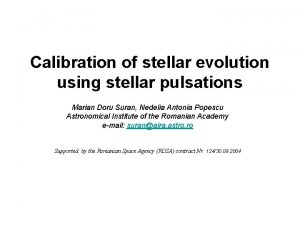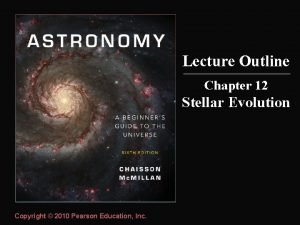Chapter 12 Stellar Evolution Copyright 2010 Pearson Education























































- Slides: 55

Chapter 12 Stellar Evolution Copyright © 2010 Pearson Education, Inc.

Copyright © 2010 Pearson Education, Inc.

The word “evolution” has a few different meanings • of a species: • Of a star: • Of an idea: Copyright © 2010 Pearson Education, Inc.

Units of Chapter 12 Leaving the Main Sequence Evolution of a Sun-like Star The Death of a Low-Mass Star Evolution of Stars More Massive than the Sun Supernova Explosions Observing Stellar Evolution in Star Clusters The Cycle of Stellar Evolution Summary of Chapter 12 Copyright © 2010 Pearson Education, Inc.

Example: How much time would an experimental study require to understand all stages of a typical human life? • With one person? • With a dozen people? • With 10, 000 people? By studying literally millions of the billions of stars we can observe, a complete and consistent model of stellar evolution has been built in the past 60 years. It includes nuclear physics, atomic physics, electromagnetism, thermodynamics, gravitation, and any other field that. Inc. can be observed and TESTED. Copyright © 2010 Pearson Education,

12. 1 Leaving the Main Sequence During its stay on the main sequence, any fluctuations in a star’s condition are quickly restored; the star is in equilibrium. How is your body temperature in equilibrium? Copyright © 2010 Pearson Education, Inc.

Clarify what “sequence” means This is the range of stars in a population. It is not the sequence of a given star’s life. A star spends the MAIN PART of it’s life on the MAIN SEQUENCE line. Copyright © 2010 Pearson Education, Inc.

12. 1 Leaving the Main Sequence Eventually, as hydrogen in the core is consumed, the star begins to leave the main sequence. Its evolution from then on depends very much on the mass of the star: Low-mass stars go quietly. High-mass stars go out with a bang! Copyright © 2010 Pearson Education, Inc.

12. 2 Evolution of a Sun-like Star Stages of a star leaving the main sequence. Know these times for a sun-like star…. 50 million years Stages 1 -6 Copyright © 2010 Pearson Education, Inc. 10 billion years Stage 7 100 million years Stages 8 -13

12. 2 Evolution of a Sun-like Star Even while on the main sequence, the composition of a star’s core is changing. And why doesn’t helium fuse to heavier elements? Copyright © 2010 Pearson Education, Inc.

12. 2 Evolution of a Sun-like Star As the fuel in the core is used up, the core contracts; when it is used up the core begins to collapse. Hydrogen begins to fuse outside the core. Copyright © 2010 Pearson Education, Inc.

Intro video https: //www. youtube. com/watch ? v=ky-ywr 0 MTk. E stellar evolution 10: 47 Copyright © 2010 Pearson Education, Inc.

Review and project 1. Start with a blank sheet of paper 2. Draw the last 7 stages of our sun’s evolution to scale. 3. Name and describe what is happening at each stage. 4. Must be neatly drawn, so use a pencil or start over if you mess up the scale. Copyright © 2010 Pearson Education, Inc.

12. 2 Evolution of a Sun-like Star Stage 9: The red giant branch: Hydrogen in inner core depleted, helium cools and collapses, releasing compression heat. This fires the shell of hydrogen fusion faster, and this energy pushes out the outer gas of the star It is now a red giant, extending out as far as the orbit of Mercury. Despite its cooler temperature, its luminosity increases enormously due to its large size. Copyright © 2010 Pearson Education, Inc.

12. 2 Evolution of a Sun-like Star The red giant stage on the H– R diagram Copyright © 2010 Pearson Education, Inc.

12. 2 Evolution of a Sun-like Star Stage 10: Helium fusion Even though outer layers swelled, inner star contracts by gravity, compressing and heating the helium inner core. Once the core temperature has risen to 100, 000 K, the helium in the core starts to fuse. Compare to Hydrogen fusion The helium flash: temperature…. Helium begins to fuse extremely rapidly; within hours the enormous energy output is over, and the star once again reaches equilibrium. Lots of Helium remains. Copyright © 2010 Pearson Education, Inc.

12. 2 Evolution of a Sun-like Star Stage 10 on the H –R diagram Can you explain why the sharp turn at the helium flash? Copyright © 2010 Pearson Education, Inc.

12. 2 Evolution of a Sun-like Star Stage 11: Back to the giant branch: As the helium in the core fuses to carbon, the core becomes hotter and hotter, and the helium burns faster and faster. The star is now similar to its condition just as it left the main sequence, except now there are two shells. This is enough to push out the surrounding hydrogen. Copyright © 2010 Pearson Education, Inc.

12. 2 Evolution of a Sun-like Star The star has become a red giant for the second time. This time it is hotter and bigger… Copyright © 2010 Pearson Education, Inc.

12. 3 The Death of a Low-Mass Star This graphic shows the entire evolution of a Sun-like star. Such stars never become hot enough for fusion past carbon to take place. Copyright © 2010 Pearson Education, Inc.

12. 3 The Death of a Low-Mass Star There is no more outward fusion pressure being generated in the core, which continues to contract. Stage 12: The outer layers of the star expand to form a planetary nebula. What does this have to do with planets? Copyright © 2010 Pearson Education, Inc.

12. 3 The Death of a Low-Mass Star The star now has two parts: • A small, extremely dense carbon core (not burning); the highest density of any star = c 1000 kg/cm 3 ntri he t e ke i c s l n e k o o loo c d o s solar y • An envelope. Wabout dof our g h opethe size n y i r h l e e l W p i system. t l env g? n mu ? i r a The envelope is called a planetary formnebula, even though it has nothing to do with planets – early astronomers viewing the fuzzy envelope thought it Silly early astronomers! resembled a planetary system. Much of the carbon vapor escapes the star, into the envelope, and into space, and is the source of carbon in Copyright © 2010 Pearson Education, Inc. our solar system….

12. 3 The Death of a Low-Mass Star Stages 13 and 14: White and black dwarfs: Once the nebula has gone, the remaining core is extremely dense and extremely hot, but quite small – the size of earth. It is luminous only due to its high temperature. Copyright © 2010 Pearson Education, Inc.

12. 3 The Death of a Low-Mass Star The small star Sirius B is a white dwarf binary companion of the much larger and brighter Sirius A. The Dog Star And Hubble found these white dwarf stars in M 4. Find M 4…. . Copyright © 2010 Pearson Education, Inc.

12. 3 The Death of a Low-Mass Star As the white dwarf cools, its size does not change significantly; it simply gets dimmer and dimmer, and finally ceases to glow. The gas drifts away. The star and gas and dust now look like this. (look carefully) The time for the white dwarf to cool to black is so long that no black dwarfs have formed yet, but they are expected in the distant future Copyright © 2010 Pearson Education, Inc.

12. 3 The Death of a Low-Mass Star A nova is a large white dwarf star that, instead of fading to black, flares up very suddenly and then returns slowly to its former luminosity. But why? How? Copyright © 2010 Pearson Education, Inc.

12. 3 The Death of a Low-Mass Star A white dwarf that is part of a semi-detached binary system can undergo repeated novas. Copyright © 2010 Pearson Education, Inc.

12. 3 The Death of a Low-Mass Star Material falls onto the white dwarf from its main -sequence companion. When enough material has accreted, fusion can reignite very suddenly, burning off the new material. Material keeps being transferred to the white dwarf, and the process repeats. So can our sun nova in the future? When? Copyright © 2010 Pearson Education, Inc.

In summary https: //www. youtube. com/watch ? v=BFpl. E 5 EUBz. A A cartoon: 4 min, pretty good. Or a video, 6 minutes from ESA Start at 4 minutes to see planetary nebula https: //www. youtube. com/watch? v= ze. Gx. JT 2_A 0 I Copyright © 2010 Pearson Education, Inc.

How I want you to draw the evolution to the end of the star…. . Main sequence Radius=R Red giant Expanded gas, He core collapses and fuses 100 x. R Carbon core C, He, O ash 0. 01 x. R Planetary nebula. Gases gently pushed away. 1000 x R White dwarf C, He, O ash 0. 01 x. R Copyright © 2010 Pearson Education, Inc.

12. 2 Evolution of a Sun-like Star Stages of a star leaving the main sequence. Know these times for a sun-like star…. 50 million years Stages 1 -6 Copyright © 2010 Pearson Education, Inc. 10 billion years Stage 7 100 million years Stages 8 -13

Evolution of higher mass stars • Many options, depending on mass • The heavier they are – They burn hotter – They burn faster – They make larger atoms when they finish 1. He Carbon (small star) 2. C Iron (biggest without super nova) 3. Iron all bigger atoms Copyright © 2010 Pearson Education, Inc.

Big explosions give big atoms Copyright © 2010 Pearson Education, Inc.

12. 4 Evolution of Stars More Massive than the Sun It can be seen from this H–R diagram that stars more massive than the Sun follow very different paths when leaving the main sequence. Copyright © 2010 Pearson Education, Inc.

12. 4 Evolution of Stars More Massive than the Sun High-mass stars, like all stars, leave the main sequence when there is no more hydrogen fuel in their cores. The first few events are similar to those in lower -mass stars – first a hydrogen shell, then a core burning helium to carbon, surrounded by helium- and hydrogen-burning shells. Copyright © 2010 Pearson Education, Inc.

12. 4 Evolution of Stars More Massive than the Sun Stars with masses more than 2. 5 solar masses do not experience a helium flash – helium burning starts gradually. A 4 -solar-mass star makes no sharp moves on the H–R diagram – it moves smoothly back and forth. Copyright © 2010 Pearson Education, Inc.

12. 4 Evolution of Stars More Massive than the Sun The sequence below, of actual Hubble images, shows first a very massive star, then a very unstable red giant star as it emits a burst of light, illuminating the dust around it. Copyright © 2010 Pearson Education, Inc.

12. 4 Evolution of Stars More Massive than the Sun A star of more than 8 solar masses can fuse elements far beyond carbon in its core, leading to a very different fate. Its path across the H–R diagram is essentially a straight line – it stays at just about the same luminosity as it cools off. Eventually the star dies in a violent explosion called a supernova. Copyright © 2010 Pearson Education, Inc.

12. 4 Evolution of Stars More Massive than the Sun Copyright © 2010 Pearson Education, Inc.

12. 5 Supernova Explosions A supernova is incredibly luminous, as can be seen from these curves – more than a million times as bright as a nova. Copyright © 2010 Pearson Education, Inc.

12. 5 Supernova Explosions A supernova is a one-time event – once it happens, there is little or nothing left of the progenitor star. There are two different types of supernovae, both equally common: Type I, which is a carbon-detonation supernova; makes a great standard candle for knowing the luminosity in space, and thus the distance. Type II, which is the death of a high-mass star. Copyright © 2010 Pearson Education, Inc.

12. 5 Supernova Explosions Carbon-detonation supernova: White dwarf that has accumulated too much mass from binary companion If the white dwarf’s mass exceeds 1. 4 solar masses, electron degeneracy can no longer keep the core from collapsing. Carbon fusion begins throughout the star almost simultaneously, resulting in a carbon explosion. Copyright © 2010 Pearson Education, Inc.

12. 5 Supernova Explosions This graphic illustrates the two different types of supernovae. Copyright © 2010 Pearson Education, Inc.

12. 5 Supernova Explosions Supernovae leave remnants – the expanding clouds of material from the explosion. Look at SWAB blog… The Crab Nebula is a remnant from a supernova explosion that occurred in the year 1054. Copyright © 2010 Pearson Education, Inc.

Look for Betelgeuse in Stellarium? • Type-II supernova in next 1 million years • We’ll see light, but no shock wave Copyright © 2010 Pearson Education, Inc.

17 apr: 12. 6 Observing Stellar Evolution in Star Clusters The following series of H–R diagrams shows how stars of the same age, but different masses, appear as the cluster as a whole ages. After 10 million years, the most massive stars have already left the main sequence, whereas many of the least massive have not even reached it yet. Copyright © 2010 Pearson Education, Inc.

12. 6 Observing Stellar Evolution in Star Clusters After 100 million years, a distinct mainsequence turnoff begins to develop. This shows the highest-mass stars that are still on the main sequence. After 1 billion years, the main-sequence turnoff is much clearer. Copyright © 2010 Pearson Education, Inc.

12. 6 Observing Stellar Evolution in Star Clusters After 10 billion years, a number of features are evident: The red giant, subgiant, asymptotic giant, and horizontal branches are all clearly populated. White dwarfs, indicating that solar-mass stars are in their last phases, also appear. Copyright © 2010 Pearson Education, Inc.

12. 6 Observing Stellar Evolution in Star Clusters This double cluster, h and Persei, must be quite young – its H– H–R diagram is that of a newborn cluster. Its age cannot be more than about 10 million years. Copyright © 2010 Pearson Education, Inc.

12. 6 Observing Stellar Evolution in Star Clusters The Hyades cluster, shown here, is also rather young; its main-sequence turnoff indicates an age of about 600 million years. Copyright © 2010 Pearson Education, Inc.

12. 6 Observing Stellar Evolution in Star Clusters This globular cluster, M 80, is about 10 -12 billion years old, much older than the previous examples. Copyright © 2010 Pearson Education, Inc.

12. 7 The Cycle of Stellar Evolution Star formation is cyclical: stars form, evolve, and die. In dying, they send heavy elements into the interstellar medium. These elements then become parts of new stars and solar systems. And so it goes. Copyright © 2010 Pearson Education, Inc. “We are all star stuff”

Quiz: fill in the blanks Stages of a star leaving the main sequence. Know these times for a sun-like star…. 50 million years Stages 1 -6 Copyright © 2010 Pearson Education, Inc. 10 billion years Stage 7 100 million years Stages 8 -14

Summary of Chapter 12 • Once hydrogen is gone in the core, a star burns hydrogen in the surrounding shell. The core contracts and heats; the outer atmosphere expands and cools. • Helium begins to fuse in the core, as a helium flash. The star expands into a red giant as the core continues to collapse. The envelope blows off, leaving a white dwarf to gradually cool. • Nova results from material accreting onto a white dwarf from a companion star. Copyright © 2010 Pearson Education, Inc.

Summary of Chapter 12, cont. • Massive stars become hot enough to fuse carbon, then heavier elements, all the way to iron. At the end, the core collapses and rebounds as a Type II supernova. • Type I supernova is a carbon explosion, occurring when too much mass falls onto a white dwarf. • All heavy elements are formed in stellar cores or in supernovae. • Stellar evolution can be understood by observing star clusters. Copyright © 2010 Pearson Education, Inc.
 Copyright 2010 pearson education inc
Copyright 2010 pearson education inc Copyright 2010 pearson education inc
Copyright 2010 pearson education inc Copyright 2010 pearson education inc
Copyright 2010 pearson education inc Copyright 2010 pearson education inc
Copyright 2010 pearson education inc Copyright 2010 pearson education inc
Copyright 2010 pearson education inc Copyright 2010 pearson education inc
Copyright 2010 pearson education inc 2010 pearson education inc
2010 pearson education inc Copyright 2010 pearson education inc
Copyright 2010 pearson education inc Copyright 2010 pearson education inc
Copyright 2010 pearson education inc Pearson education inc all rights reserved
Pearson education inc all rights reserved Stages of stellar evolution of a low-mass star
Stages of stellar evolution of a low-mass star Zero age main sequence
Zero age main sequence Stellar evolution lab the life cycle of a star
Stellar evolution lab the life cycle of a star Stellar evolution
Stellar evolution Stellar evolution
Stellar evolution Stellar evolution
Stellar evolution Hr diagram
Hr diagram 2017 pearson education inc
2017 pearson education inc Copyright by pearson education inc. answers
Copyright by pearson education inc. answers 2009 pearson education inc
2009 pearson education inc Copyright pearson education inc
Copyright pearson education inc Copyright 2014 pearson education inc
Copyright 2014 pearson education inc Copyright by pearson education inc. answers
Copyright by pearson education inc. answers Copyright 2003 pearson education inc
Copyright 2003 pearson education inc Copyright 2009 pearson education inc
Copyright 2009 pearson education inc Copyright pearson education inc
Copyright pearson education inc Copyright 2009 pearson education inc
Copyright 2009 pearson education inc 2009 pearson education inc
2009 pearson education inc Copyright 2009 pearson education inc
Copyright 2009 pearson education inc Copyright 2009 pearson education inc
Copyright 2009 pearson education inc Copyright pearson education inc
Copyright pearson education inc 2010 pearson education inc
2010 pearson education inc 2010 pearson education inc
2010 pearson education inc 2010 pearson education inc answers
2010 pearson education inc answers 2010 pearson education inc answers
2010 pearson education inc answers 2010 pearson education inc answers
2010 pearson education inc answers 2010 pearson education inc
2010 pearson education inc 2010 pearson education inc
2010 pearson education inc 2010 pearson education inc
2010 pearson education inc The four forces shown have the same strength
The four forces shown have the same strength 2010 pearson education inc answers
2010 pearson education inc answers 2010 pearson education inc
2010 pearson education inc Pearson education 2010
Pearson education 2010 Pearson education inc. all rights reserved
Pearson education inc. all rights reserved 2010 pearson education inc answers
2010 pearson education inc answers 2010 pearson education inc
2010 pearson education inc 2010 pearson education inc
2010 pearson education inc 2010 pearson education inc answers
2010 pearson education inc answers 2010 pearson education inc answers
2010 pearson education inc answers 2010 pearson education inc
2010 pearson education inc 2010 pearson education inc
2010 pearson education inc 2010 pearson education inc answers
2010 pearson education inc answers 2010 pearson education inc answers
2010 pearson education inc answers 2010 pearson education inc answers
2010 pearson education inc answers Pearson education inc. publishing as prentice hall
Pearson education inc. publishing as prentice hall Pearson education, inc. publishing as prentice hall
Pearson education, inc. publishing as prentice hall










